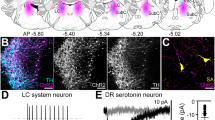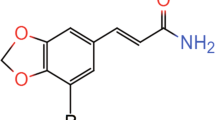Abstract
CONSIDERABLE evidence exists that the tricyclic antidepressant drugs are selective inhibitors of monoamine uptake into monoaminergic nerve terminals1,2. These drugs also potentiate pharmacological responses to the monoamines in both the peripheral and central nervous systems3–6. These effects do not explain the discrepancy between the time-course of the biochemical and pharmacological responses which are elicited by these antidepressant drugs within minutes or hours and their clinical antidepressant action which requires treatment for weeks for efficacy to be reached. Furthermore, desipramine, an antidepressant drug, can potentiate neuronal responses to noradrenaline and dopamine in the caudate nucleus7, although it does not block the catecholamine uptake in this area of the brain1,2. Finally the antidepressant iprindole does not influence noradrenaline turnover8 or metabolism9,10 or its uptake into catecholaminergic neurones11, but is effective in potentiating the responses of single cortical and caudate neurones to monoamines12. Vetulani and his associates13 suggested that the therapeutic action of tricyclic antidepressants may be related to postsynaptic adaptive changes in the sensitivity of the noradrenergic adenylate cyclase receptor system rather than to acute presynaptic events. The purpose of the experiments described here was to explore the molecular basis for antidepressant-induced noradrenergic subsensitivity by examining the kinetic properties of the β-adrenergic receptors in the microsomal suspension of rat brain by using a potent β-adrenergic receptor antagonist 3H-dihydroalprenolol as a radiolabelled ligand14–19. Our results indicate that the main mechanism is a reduction in the number of receptors.
This is a preview of subscription content, access via your institution
Access options
Subscribe to this journal
Receive 51 print issues and online access
$199.00 per year
only $3.90 per issue
Buy this article
- Purchase on Springer Link
- Instant access to full article PDF
Prices may be subject to local taxes which are calculated during checkout
Similar content being viewed by others
References
Iversen, L. L., Biochem. Pharmac. 23, 1927–1935 (1974).
Horn, A. S., Coyle, J. T. & Snyder, S. H. Molec. Pharmac. 7, 66–80 (1971).
Sigg, E. B., Soffer, L. & Gyermek, L. J. Pharmac. exp. Ther. 142, 13–20 (1963).
Bradshaw, C. M., Roberts, M. H. T. & Szabadi, E. Br. J. Pharmac. 52, 349–358 (1974).
Schildkraut, J. J. Am. J. Psychiat. 122, 509–522 (1965).
Schildkraut, J. J. & Kety, S. S. Science 156, 21–30 (1967).
Beven, P., Bradshaw, C. M. & Szabadi, E., Br. J. Pharmac. 54, 285–294 (1975).
Rosloff, B. N. & Davis, J. M. Psychopharmacologia 40, 53–64 (1974).
Lahti, R. A. & Maickel, R. P. Biochem. Pharmac. 20, 482–486 (1971).
Freeman, J. J. & Sulser, F. J. Pharmac. exp. Ther. 183, 307–315 (1972).
Ross, S. B., Renyi, A. L. & Ogren, S. O. Life Sci. 10, 1267–1277 (1971).
Beven, P., Bradshaw, P. M. & Szabadi, E. Br. J. Pharmac. 55, 17–25 (1975).
Vetulani, J., Stawarz, R. J., Dingell, J. V. & Sulser, F. Naunyn Schmiedelberg's Arch. Pharmac. 293, 109–114 (1976).
Lefkowitz, R. J., Mukherjee, C., Coverstone, M. & Caron, M. C. Biochem. biophys. Res. Commun. 60, 703–709 (1974).
Mukherjee, C., Caron, M. C., Coverstone, M. & Lefkowitz, R. J. J. biol. Chem. 250, 4869–4876 (1975).
Lefkowitz, R. J. Biochem. Pharmac. 24, 583–590 (1975).
Alexander, R. W., Davis, J. N., & Lefkowitz, R. J. Nature 258, 437–439 (1975).
Nahorski, S. R. Nature 259, 488–489 (1976).
Bylund, D. B. & Snyder, S. H. Molec. Pharmac. 12, 568–580 (1976).
Scatchard, G. Ann. N. Y. Acad. Sci. 51, 660–672 (1949).
Kalisker, A., Rutledge, C. D. & Perkins, J. P. Molec. Pharmac. 9, 619–629 (1973).
Huang, M., Ho, A. K. S. & Daly, J. W. Molec. Pharmac. 9, 711–717 (1973).
Dismukes, K. & Daly, J. W. Molec. Pharmac. 10, 933 (1974).
Mukherjee, C., Caron, M. G. & Lefkowitz, R. J. Proc. natn. Acad. Sci. U.S.A. 72, 1945–1949 (1975).
Author information
Authors and Affiliations
Rights and permissions
About this article
Cite this article
BANERJEE, S., KUNG, L., RIGGI, S. et al. Development of β-adrenergic receptor subsensitivity by antidepressants. Nature 268, 455–456 (1977). https://doi.org/10.1038/268455a0
Received:
Accepted:
Issue Date:
DOI: https://doi.org/10.1038/268455a0
This article is cited by
-
The Neurobiology of Depression: an Integrated Overview from Biological Theories to Clinical Evidence
Molecular Neurobiology (2017)
-
Permanent Relief from Intermittent Cold Stress-Induced Fibromyalgia-Like Abnormal Pain by Repeated Intrathecal Administration of Antidepressants
Molecular Pain (2011)
-
Pharmacogenomic Evaluation of the Antidepressant Citalopram in the Mouse Tail Suspension Test
Neuropsychopharmacology (2006)
Comments
By submitting a comment you agree to abide by our Terms and Community Guidelines. If you find something abusive or that does not comply with our terms or guidelines please flag it as inappropriate.



